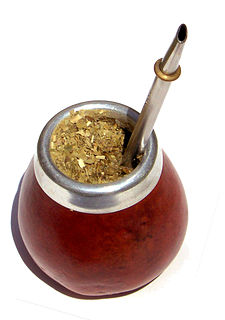Mate (beverage)

Mate in a traditional calabash gourd
|
|
| Type | Infusion, hot |
|---|---|
| Country of origin | Paraguay, Uruguay, Argentina, Bolivian Chaco, Brazil |
| Introduced | 16th century AD |
Mate (Spanish: [ˈmate], Portuguese: [ˈmatʃi]; sometimes hypercorrected as maté in English, but never in Spanish or Portuguese, where it is often called "jerba"), also known as yerba mate, chimarrão (Portuguese: [ʃimɐˈʁɐ̃w̃]) or cimarrón (Spanish: [simaˈron]), is a traditional South American caffeine-rich infused drink, particularly in Argentina (where it is defined by law as the "national infusion"), Uruguay, Paraguay, the Bolivian Chaco, and Southern Brazil. It is also consumed in Syria, the largest importer in the world, and by the Druze in Lebanon.
It is prepared by steeping dried leaves of yerba mate (Ilex paraguariensis, known in Portuguese as erva-mate) in hot water and is served with a metal straw from a shared hollow calabash gourd. The straw is called a bombilla in Spanish, a bomba in Portuguese, and a bombija or, more generally, a masassa (type of straw) in Arabic. The straw is traditionally made of silver. Modern, commercially available straws are typically made of nickel silver, called alpaca; stainless steel, or hollow-stemmed cane. The gourd is known as a mate or a guampa; while in Brazil, it has the specific name of cuia, or also cabaça (the name for Indigenous-influenced calabash gourds in other regions of Brazil, still used for general food and drink in remote regions). Even if the water is supplied from a modern thermos, the infusion is traditionally drunk from mates or cuias.
...
Wikipedia
